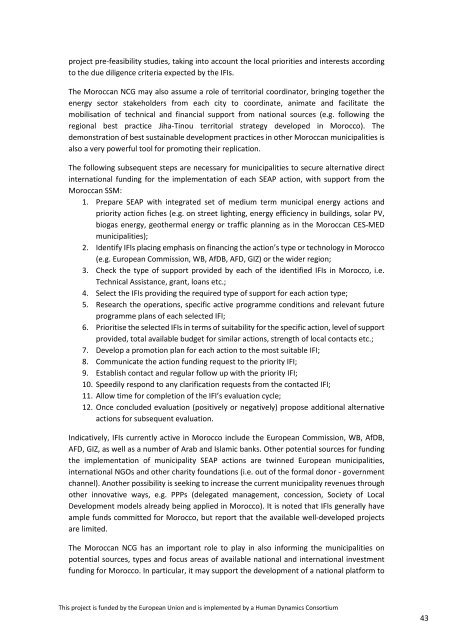311017_CESMED Funding_Mechanisms_Final
You also want an ePaper? Increase the reach of your titles
YUMPU automatically turns print PDFs into web optimized ePapers that Google loves.
Morocco. The Moroccan NCG’s main role is to sustain technical assistance to municipalities,<br />
providing training and coaching help desk similar to that provided by CES-MED specifically<br />
upon the termination of this project. Another source of technical (and maybe even financial)<br />
assistance for preparing a municipality SEAP may be from another twinned European<br />
municipality.<br />
Once SEAP preparation is included in the PCD of a municipality, and thus the municipality’s<br />
commitment to sustainable energy development emphasised, it will be easier to secure<br />
(around 50%) national co-financing for this from the FEC. Alternative funding sources could<br />
be international donor or other IFI projects, e.g. similar to the present CES-MED or SUDEP<br />
projects by the European Commission.<br />
An indicative preliminary review / checklist of regional and local characteristics relevant to the<br />
preparation of a SEAP by a Moroccan municipality is presented in Annex A.1. The initial<br />
completion of this checklist will allow IFIs in particular to speedily understand and initially<br />
prioritise requests for funding the preparation of SEAPs from municipalities.<br />
8.3. Municipality <strong>Funding</strong> Guidelines for Implementation of SEAP Actions<br />
Once a municipality SEAP has been prepared, a good first step for this to gain international<br />
and also increase its national credibility is to be accepted by the European Commission,<br />
allowing the municipality to become a signatory of the CoM. It is noted that SEAPs have<br />
already been accepted from the Moroccan municipalities of Agadir, Benslimane and Oujda<br />
prepared through the present CES-MED project, as well as from Salé. Once included in a<br />
municipality’s SEAP as well as its PCD priority investments list, an action has good chances of<br />
being financed from the FEC or other national sources, through a large array of sophisticated<br />
financing instruments:<br />
• Direct subsidies, e.g. via the DGCL, to projects allowing municipalities to improve the<br />
quality of a public service;<br />
• Indirect subsidies, via the relevant sectoral departments, for measures to improve the<br />
environmental quality or reduce the energy consumption of a specific sub-sector;<br />
• Third party investments, via the EIS, alongside private investors likely to compensate<br />
for the absence of a guarantee of State;<br />
• Appropriations, via the FEC, intended exclusively for municipalities;<br />
• Support to local networks, e.g. via the DGCL, ADEREE, MEMEE or FEC, for<br />
strengthening the capacity of the municipalities.<br />
The next necessary step for each action included in the municipality SEAP is its elaboration in<br />
the form of a priority action fiche, e.g. as in the practical form applied in the present CES-MED<br />
project or in another more elaborate form developed for climate change projects, presented<br />
in Annexes A.2 and A.3 respectively. It is very important for municipalities to focus on their<br />
priority investments in order to develop their planning in more detail, rather than to embark<br />
on developing a large number of less well prepared investment proposals. The Moroccan NCG<br />
may ensure the optimal coordination between IFIs and the State in developing high quality<br />
This project is funded by the European Union and is implemented by a Human Dynamics Consortium<br />
42

















